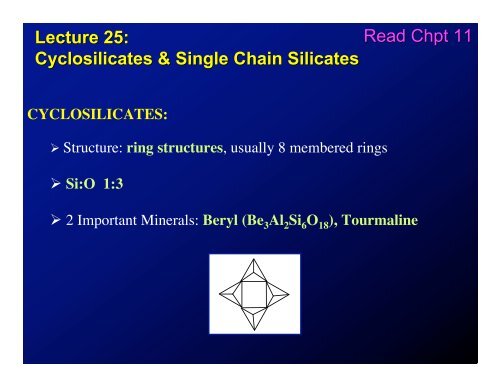Lecture 25: Cyclosilicates & Single Chain Silicates Read Chpt 11
Lecture 25: Cyclosilicates & Single Chain Silicates Read Chpt 11
Lecture 25: Cyclosilicates & Single Chain Silicates Read Chpt 11
Create successful ePaper yourself
Turn your PDF publications into a flip-book with our unique Google optimized e-Paper software.
<strong>Lecture</strong> <strong>25</strong>:<br />
<strong>Cyclosilicates</strong> & <strong>Single</strong> <strong>Chain</strong> <strong>Silicates</strong><br />
<strong>Read</strong> <strong>Chpt</strong> <strong>11</strong><br />
CYCLOSILICATES:<br />
! Structure: ring structures, usually 8 membered rings<br />
! Si:O 1:3<br />
! 2 Important Minerals: Beryl (Be 3 Al 2 Si 6 O 18 ), Tourmaline
2 Important Cyclosilicate Minerals:<br />
(1) Beryl (Be 3 Al 2 Si 6 O 18 )<br />
! Distinguishing Properties: H=7.5-8; no good cleavage; crystal<br />
habit often hexagonal prisms<br />
! Occurrence: associated with granites, especially pegmatites<br />
(late stage magmas, highly enriched in “incompatible” elements)<br />
! Uses: aquamarine (Fe impurity), emerald (Cr impurity), source<br />
of Be<br />
! Symmetry: hexagonal
Beryl<br />
Colorado<br />
Mineral Galleries<br />
Beryl<br />
Utah<br />
Mineral Galleries<br />
Beryl<br />
China<br />
Mineral Galleries
2 Important Cyclosilicate Minerals:<br />
(2) Tourmaline (very complex!! Na, Ca, Li, Mg, Al, Fe, Mn, BO 3 ,<br />
OH…)<br />
! Distinguishing Properties: triangular cross section; 3- or 6-<br />
sided prisms; striations; H=7-7.5, pleochroic, piezoelectric;<br />
many colors (black, green, pink, brown)<br />
! Occurrence: usually associated with pegmatites<br />
! Uses: semiprecious gem; source of B<br />
! Varieties: elbaite (watermelon); schorl (black); dravite<br />
! Symmetry: hexagonal
Tourmaline (8 cm across)<br />
Champion mine, Marquette County, Michigan<br />
A. E. Seaman donor (DM<strong>11</strong>471)<br />
John A. Jaszczak photo.<br />
Seaman Museum<br />
Elbaite (4 cm) with quartz and feldspar.<br />
(From Foote Mineral Company) Elba, Italy<br />
John A. Jaszczak photo. Seaman Museum.
Tourmaline (Elbaite)<br />
Pala, California<br />
Photo by Mary Sutherland<br />
James Madison U.
SINGLE CHAIN SILICATES<br />
General Formula: XYSi 2 O 6<br />
X=6-fold coordinated site<br />
Y=8-fold coordinated site
SINGLE CHAIN SILICATES<br />
Pyroxenes vs. Pyroxenoids<br />
• difference in “twisting”, symmetry of chains<br />
• most important pyroxenoid: wollastonite (CaSiO 3 )
Important Pyroxenoid:<br />
Wollastonite (CaSiO 3 )<br />
! Distinguishing Characteristics: usually white color; 2 perfect<br />
cleavages at 90°; usually massive; H=5.5<br />
!Occurrence: “skarns”, metamorphosed quartz, calcite<br />
(decarbonation reaction)<br />
! Symmetry: triclinic
Wollastonite<br />
(fluorescence)<br />
New Jersey<br />
Mineral Galleries<br />
Wollastonite<br />
New York<br />
Mineral Galleries
PYROXENES<br />
! based on single chain silicate backbone<br />
! most important Fe, Mg bearing silicate minerals, they occur in<br />
nearly every igneous rock type<br />
“I-Beam Structure”<br />
M2 site<br />
a sin !<br />
M1 site<br />
b<br />
M1 site: small, undistorted, 6-fold, all O nonbridging, contains smaller cations<br />
(Al +3 , Fe +3 , Cr +3 , Ti +4 )<br />
M2 site: larger, more distorted, 6- or 8-fold, contains larger cations (Li + , Na + )
Pyroxene Quadrilateral<br />
Ca 2<br />
Si 2<br />
O 6<br />
(wollastonite)<br />
MgCaSi 2<br />
O 6<br />
(diopside)<br />
Mg 2<br />
Si 2<br />
O 6<br />
(enstatite)<br />
augite<br />
pigeonite<br />
orthopyroxenes<br />
FeCaSi 2<br />
O 6<br />
(hedenbergite)<br />
Fe 2<br />
Si 2<br />
O 6<br />
(ferrosilite)
PYROXENES<br />
Orthopyroxene (enstatite, bronzite, hypersthene, ferrosilite)<br />
Ca-poor (1.5 wt%)<br />
Ca in 8-fold M2 sites<br />
Solid solution:<br />
High T: complete pigeonite-augite solid solution<br />
Low T: M2 sites are too small, form exsolution lamellae<br />
Stacking: ++++<br />
Symmetry: monoclinic
Enstatite (Orthopyroxene)<br />
Tanzania<br />
Mineral Galleries<br />
Augite (Clinopyroxene)<br />
Canada<br />
Mineral Galleries
Physical Properties of Pyroxene Minerals:<br />
! cleavage angle at 92-93, 87-88°C<br />
! stubby to slightly elongate crystal habit<br />
! dark colored (black to green)<br />
! hardness: 5.5-7
Pyroxene Minerals not on Pyroxene Quadrilateral:<br />
Spodumene (LiAlSi 2 O 6 )<br />
! Distinguishing properties: typically white<br />
! Occurrence: associated with pegmatites<br />
! Uses: important Li source, also two semiprecious gems<br />
(kunzite, hiddenite)<br />
Jadeite (NaAlSi 2 O 6 )<br />
! Distinguishing properties: apple-green<br />
! Occurrence: high P, T metamorphic rocks<br />
! Uses: source of jade
Jadeite<br />
California<br />
Mineral Galleries<br />
Spodumene (Var. Kunzite)<br />
Mawi Lagham Province, Afghanistan<br />
Photo by Mary Sutherland.<br />
James Madison University

















